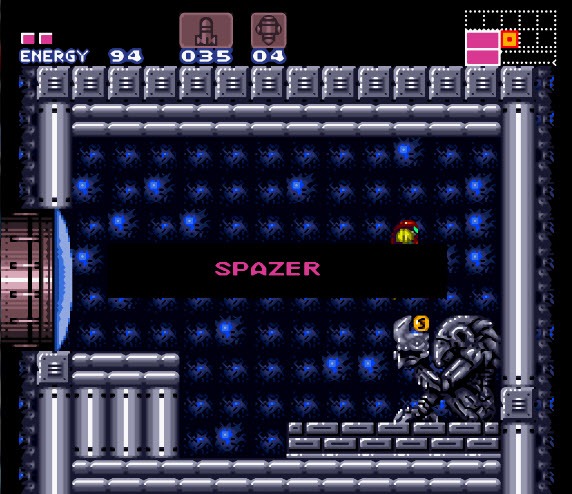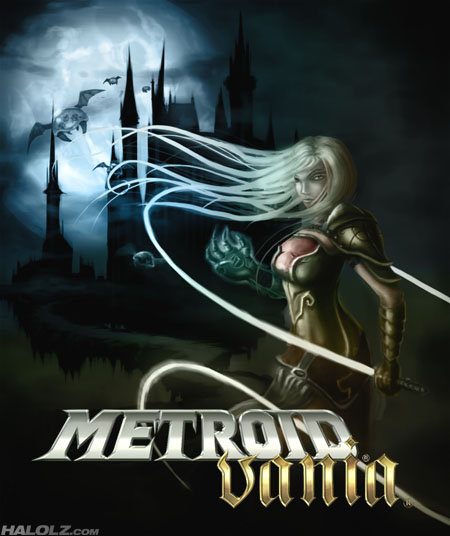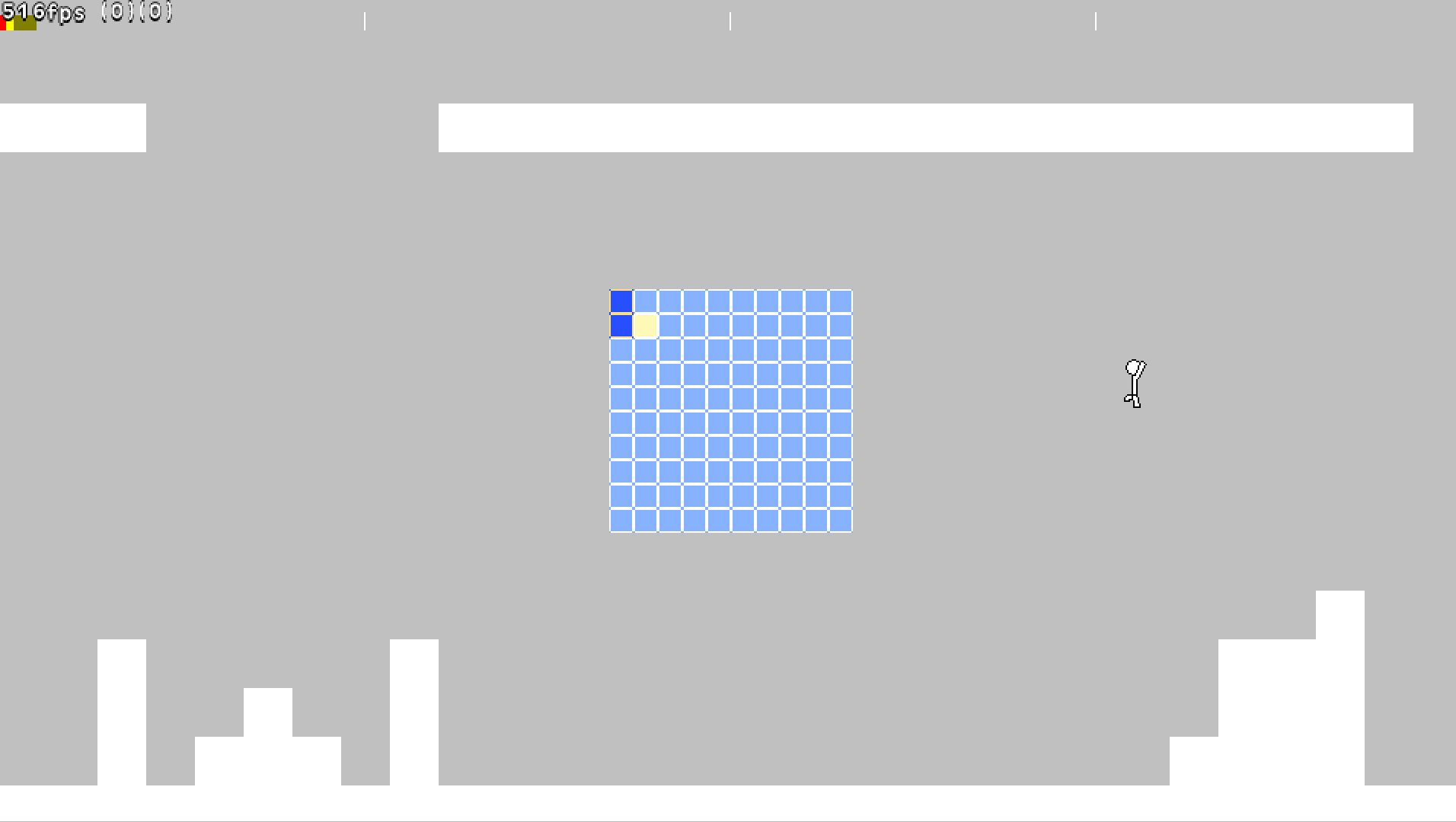For the last 2 weeks, I’ve been applying the scripting skills I’ve built over the last 15 months to construct an RPG platformer in the vein of Super Metroid. Being a game design student of course means I’ve been less than a stranger to working on 2D platformers of varying scopes, with development cycles ranging from 48 hours, up to nearly 3 months, but none carrying the same non-linear structure, statistics tracking, or progression / navigation tracking that games of this nature entail.
To begin with, I decided I should look back to my experience with the ‘Metroid-vania’ sub-genre of platformers to see the design principles I would need to adapt from. Unfortunately, as with many other young designers I know, what knowledge I have of the basic principles outweighs my actual experience with one genre or another; non-linear RPG platformers being one of them.
Super Metroid: I bought it on WiiWare in 2008, and have probably clocked under an hour of playtime, just making it past the Spore boss. Symphony of the Night: despite gruffly yelling “WHAT IS A MAN” here and there in idle conversation, I have not played. Other classic staples such as Blaster Master, Kirby & the Amazing Mirror, Shantae, Zelda II, etc. I either haven’t experienced first-hand, or have had only dwindling time with. I have since acquired many of these titles to rectify that mistake.
I then looked to more modern examples of the sub genre. Shadow Complex was a no-go as I don’t own a 360; Dark Souls (which many state is a good 3D pseudo-example of the progression principles of ‘Metroid-vania’) I have yet to play; Indie examples such as Cave Story, La Mulana, and The Iconoclasts I’ve only just come into possession of, and many sit in queue with dozens of other important titles I’ve accrued in my backlog.
Despite this hole in my repertoire, there was thankfully one title which I’ve had extensive play-time with, that not only highlights key points of the sub-genre as a whole, but prominently displays what I consider its greatest principle in the area of an explorative non-linear experience. The game I speak of is Vanillaware’s Muramasa: the Demon Blade.

‘Oboro Muramasa’ contains a clear-cut example of level design
and progression methodology that is core to the ‘Metroid-vania’ experience.
Muramasa very prominently (and some would say bluntly) presents the basic structure of the exploration and progression design principles in the ‘Metroid-vania’ style of games, in the form of its colour-coded energy barriers. The player can destroy these barriers with their titular demonic swords only when they have acquired the ability to destroy barriers of that corresponding colour. Such abilities are acquired at the end of specific story sequences the player is directed to on their map. Being able to break through new barriers, the player is able to access new provinces on their world (well, Japan) map, as well as access previously inaccessible areas of provinces they’ve already visited, often containing helping equipment, or new boss challenges to overcome.
The placement of these barriers are divided thus: the essential ones wall off the player into specific portions of the map, to ensure the boundaries they remain in will nudge them towards the next story event, which in turn will lead them to a new portion of the game world with similar boundaries. Then there are the non-essential barriers, which hide bonus content to encourage players to explore and backtrack through the game world to acquire them. These also help relieve the tedium of backtracking necessitated by the narrative progression; the maps, with new things to nab and see and fight feel refreshing and different, to a degree.
The methodology presented by Muramasa, and can be found in nearly every game that falls under this sub-genre, is as follows:
The player begins navigating their 2D world until at some inevitable point, they encounter an object that gives the impression it can be interacted with, but with the player character’s current abilities, that is not possible. Inspecting nearby reveals an object that the player CAN interact with in their current state. After traversing a path whose linearity is likely dependent on how close the player is to the final boss, narrative wise, the player encounters yet another object, that bestows a previously unavailable skill, ability, or function for them to utilize in their play space. Said function is near-certain to be just what the player needs to interact with the object they saw a few minutes earlier, and so, retracing their steps they return, and enter a previously inaccessible area of the game world. This dance of dangling obstacles before the player and daring them to find a way to get past them repeats itself for most of the game’s duration.

This design principle, in its execution in games pertaining to this sub-genre, gives players the room for exploration and discovery, while still placing them down a largely unavoidable path to each major narrative event. This is something of a sadistic variant of the level design methods typified in open world 3D games, such as Bethesda’s Elder Scrolls series: here, the game environment is laid out in bumpy, hilly terrain, to obstruct the player’s view enough that they can only see so far in their immediate area, but pique their curiosity of what lies over the next hill, around the next building, etc. The principles seen in those games are meant to encourage players to veer far off the ‘main quest’ path, while allowing them to be guided back to it at any point they so choose (such as through fast-travel). Both methods gesture the player to experience new content in new places in their worlds; the tundras of Skyrim, and rocky steppes of the Mojave Wasteland beckon players to keep going further and further in their stretches of playable space, whereas the likes of Planet Brinstar taunt the player to find ways to move forward, with high-perched ledges, and boulders yielding only to high explosives.

Level design in games such as The Elder Scrolls series encourage players to explore their worlds freely, rather than blocking players with obstacles that can only be overcome through exploration.
Returning to the main subject, although Muramasa presents this principle in an opaque fashion, it becomes plain to see how it is utilized in games like Super Metroid, or Castlevania. From the outside looking in, one would assume players cannot complete a game of this kind without either a copy of Nintendo Power (R.I.P.) 20 years ago, or a GameFAQs walkthrough today; that players need to step upon every square inch of traversable space to be able to decipher the path to a necessary upgrade; that players need every ability under their belt in order to complete the story-line in any fashion, and have to rush through the game at break-neck speed or risk receiving an ‘unsatisfying’ ending sequence. In actuality, players can typically complete a game like these in a fashion they deem fit for themselves, without unearthing certain upgrades that alleviate some difficulty from the game (or avoid them on purpose to add to the challenge…). The player could potentially miss items or other content that has great significance and still finish the game, such as in Symphony of the Night; the player doesn’t get the “true” ending unless they acquire a specific item earlier on, which allows them to see another enemy during what would normally be the final boss.
Now, the progress of my project thus far is a bit bare bones. I have player platform physics down, as well as wall-jumping, though I’m considering heavily reworking that due to some odd glitches arising. I have the framework of a leveling and stat system, and have even been learning about Surfaces in order to create some sweet visual effects. However, I can’t quite call this anything other than a basic platformer until I nail down a working map system to track player position in a persistent game world.
My next post on the matter will (hopefully) contain some pre-alpha footage of the project, some discussion on the significance and best implementation of narrative in the Metroid-vania sub-genre and what makes the myriad of boss encounters in games like them so intriguing.
Goodbye, for now.
————– Herb



